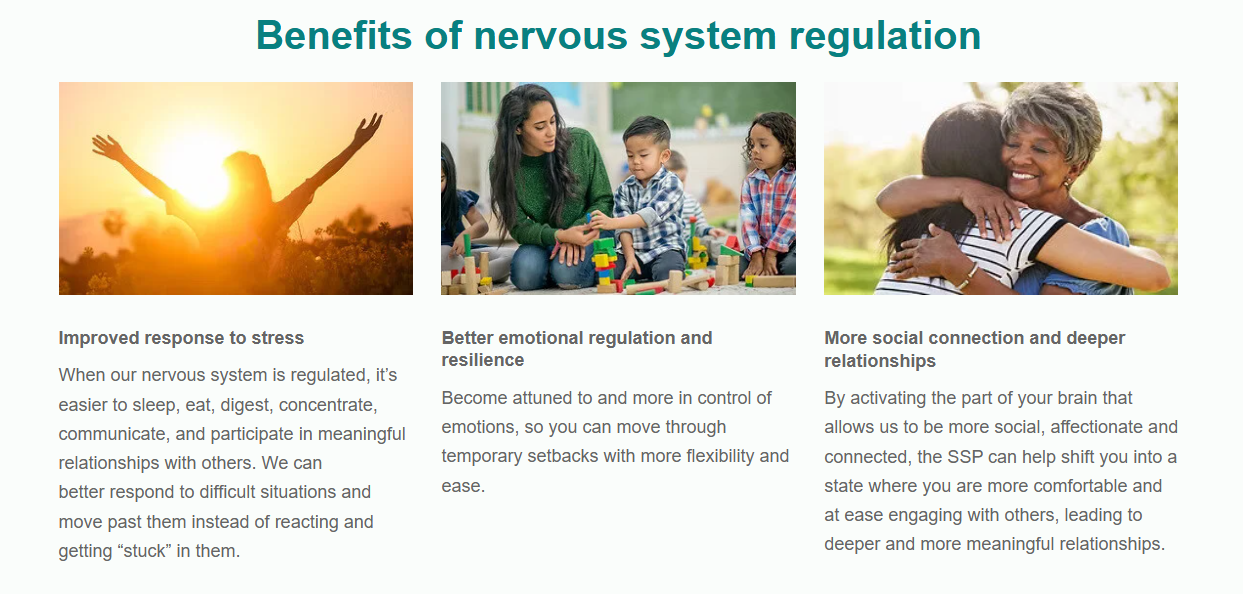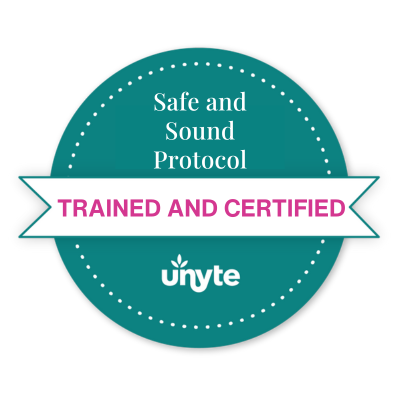SSP Safe and Sound Protocol
What I’m hearing from my own clients:
*
Calmer
*
Happier
*
Less meltdowns
*
More confident
*
Less anxious
*
More independent
*
Looks forward to it
*
Better anger control
*
Sleeps easier
*
More talkative
*
Gets along better with siblings
*
Homework is easier
*
Not scared to be alone
*
Less defensive
*
More cooperative in games and sports
*
Happier and lighter
*
180 turn around
* Calmer * Happier * Less meltdowns * More confident * Less anxious * More independent * Looks forward to it * Better anger control * Sleeps easier * More talkative * Gets along better with siblings * Homework is easier * Not scared to be alone * Less defensive * More cooperative in games and sports * Happier and lighter * 180 turn around
From the Research
Improvements and Benefits
While we can't predict which improvements will show up for any one person, here is a list of common known improvements:
Increased feelings of calmness
Less defensiveness
Less easily stressed
Reduced anxiety, especially social anxiety
Decreased panic, fears and phobias
Easier to overcome & tolerate challenges
Less anger, meltdowns, outbursts
Finding transitions much easier
Change in throat tension/sound of voice
Speech and language improvements
Improved self-awareness (particularly in relation to emotions)
Improved communication about self (particularly in relation to emotions)
Improved reciprocal communication
More able to put words to feelings
Increased sense of humor
Improved assertiveness and self protectiveness
Improved comprehension
Easier to follow directions
Improved processing speed
Improved organization
Thoughts and behavior have more purposeful flow
More able to remain regulated during face to face communication
Improved eye contact
Improved ability to read social cues
Increased displays of affection-seeking affection-expressive contact
Improved visual focus/tracking
Improved cardiac function (HRV, resting heart rate)
Improvement in breathing patterns
Improved digestion
Improved bladder control
Hormonal shifts for women
Concerns related to long covid
Hearing changes
Reductions in sensory hypersensitivities generally
Reduced sensitivity to food tastes and textures/less "picky eating"
Reduced or eliminated sound sensitivities, including misophonia & hyperacusis
More able to tolerate busy environments
Reduced repetitive motions and restlessness
Increased facial flexibility and expressiveness
Increased body flexibility
Improved dexterity
Reduced chronic pain
The Safe and Sound Protocol (SSP) is an evidence based powerful listening therapy designed to help regulate the nervous system, so you can better connect with yourself, others and the world around you.
Through specially filtered music listened to through headphones alongside a provider in person or remotely, the SSP sends cues of safety to your nervous system, building the foundation for awareness, embodiment and resilience.
Suitable for children and adults, the SSP has demonstrated benefits for individuals with trauma, anxiety, sensory processing differences and more.
Here is a brief video to learn more.
As you listen to the music of the SSP, highlighted frequencies send cues of safety to retune your nervous system, which can help you feel more settled, engaged and balanced.
The SSP Process
I will create a personal account for you on the Unyte platform that you log into with your email address. You can log on to this website with your laptop, tablet, or phone. There you will see:
Introductory information and videos
Pre and post listening assessments
Samples of the different music playlists
Your dashboard will have your listening sessions listed so that you can see where you are if needed
A link to the Unyte app where all the listening happens
Resources - more information about the SSP and nervous system as well as regulatory activities
Unyte app
Can be used on a phone or tablet (not a laptop)
All listening happens through this app
Getting started with me
We’ll start with an initial session (more if indicated) either in person or online
You’ll complete paperwork before this session so I can become familiar with your situation
I’ll explain and answer any questions about this listening therapy
I’ll explain how to administer this therapy to yourself or your child
Access to ONE license for ONE year of SSP is $300.
One round can usually be completed within a couple of months, so several rounds can be completed in a year.
Insurance cannot be billed for access
The initial session with me and any other sessions that are needed are $150.
Insurance can be billed for the sessions (I am paneled with EMI and most SelectHealth plans)
other details
The SSP is delivered through the app and over the ear headphones (earbuds cannot be used)
The headphones must completely cover or surround the ear, not sit on top of the ear
No noise cancelling, or the ability to turn noise cancelling off
No bass boost or other enhancements
They can be either wired or wireless
Some children or individuals are not able to tolerate over the ear headphones and we have workarounds for this
The standard delivery of SSP is a maximum of 30 minutes every other day with a supportive person (co-regulator) present
The co-regulator is present to provide calm and supportive energy and to help regulate and soothe if needed
In some situations it can be very difficult to find a co-regulator or feel safe with another person and again we have workarounds for this
Many of my clients find that listening every other day is difficult to remember or that 30 minutes is too much time, so alternatively, it is an option to listen daily for 5, 10, or 15 minutes
Because the filtering in the music is directly affecting the nervous system it is important that we not overwhelm the nervous system
you cannot go too slowly, but you can go too fast and experience uncomfortable physical sensations and emotional dysregulation
If that occurs I can guide you through managing the discomfort and dysregulation
While listening you or your child can
snuggle, back tickles or scratches
petting or snuggling with a pet
fidgets, sensory items
color, draw, engage in light easy art
crochet, simple crafts
gentle movement or stretching
Legos or easy mindless playing
The music needs to be listened to and focused on so
no reading, writing, homework
no screens or electronics
talking kept to a minimum (parents may wear their own earbuds or headphones as a visual cue to not talk)
nothing very vigorous
SSP is a supportive therapy and does not take the place of your original therapy - CBT, ERP, EMDR, DBT, etc
SSP makes your original therapy easier to engage in since your nervous system is calmer
Sometimes you can do the SSP at the same time as your other therapy modalities, other times there needs to be several weeks or months in between
Some people see all the improvements they want to see in just one round of the SSP.
Others see benefit and would like to see continued benefit and do more rounds
Some do a round or two a year as a way to maintain and keep their nervous system well tuned
There needs to be at least 2-3 months in between rounds of SSP in order to allow the nervous system to integrate
It is important to know that it can take between two and seven weeks AFTER the entire SSP process has been completed for improvements to appear. Although many people do notice shifts appearing immediately once the process has begun, for some people they don't notice anything at all for a few weeks after completing the process and this can be quite normal as well.
testimonials
“SSP, alongside traditional therapy, is helping my daughter recognize and cope with her big feelings and anxiety more effectively. She is better able to use preventative techniques and skills to remain grounded during difficult moments. Her meltdowns are fewer and often shorter than they have been in the past. She looks forward to listening to the music everyday and enjoys the variety of music that is available. SSP seems to have helped her be more open and willing to try the skills she is taught in therapy, which then helps her feel more capable of managing her anxiety and big feelings.”
“After having my son do the SSP program, I have noticed a change in his ability to better regulate his emotions. He’s able to take a second and calm down before he has a meltdown. Things that would set him off have decreased and he can talk through those situations. It was so easy to listen for 15 minutes a day. And I love the progress we’ve seen so far!”
“He is having far less anger and outbursts now. When he does get angry he’s able to manage it much better and faster. ”
“I’m so much less defensive, less anxious, more confident and natural in social situations, and I just feel happier and lighter. ”
“I have seen significant changes in my son’s behavior doing SSP. He was resistant to talking about his anxiety so SSP has been huge in helping him conquer daily battles. It has helped him not worry so much about future events, he’s not stewing over them before they happen. He is a happier and funnier kid to be around and I’m so grateful Alivia introduced us to SSP.”
“I am so thankful that Alivia recommended the SSP and RRP listening programs for my son. He has struggled with anxiety his whole life. In the 3 months since starting the listening programs, his tolerance for uncomfortable and unfamiliar situations has improved dramatically. I recently told someone that “I don’t know what to do with myself now, I used to spend so much time and energy every day helping him manage his anxiety and now he just... manages it.” Thank you Alivia!”








